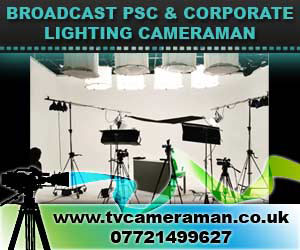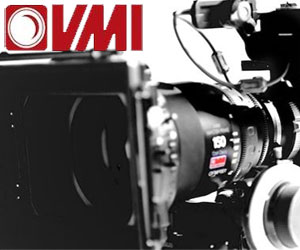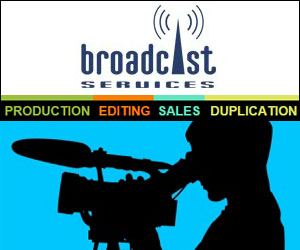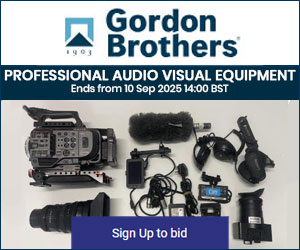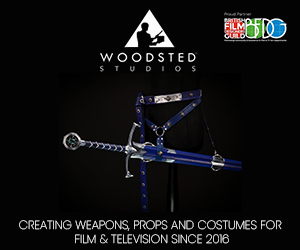Broadcast News
30/03/2016
Something Slightly Different – Sunlight
I don't know about the rest of you, but everyone here at Pixipixel is well and truly over winter.
Short cold and dull days are not exactly the stuff of great photographs or location shoots are they? This has however given me an idea…
As a departure from my normal rambling, 'Kit Of The Week' blogs I'm going to try something a little different. More along the lines of a how to guide, and what better place to start than how to recreate sunlight?
So please don't take this the wrong way, I know many of you will be well versed in this but you never know you may pick something up, even if it's only a nice tan.
Firstly a small bit of Brucie theory:
Sunlight (I'm talking about a bright blue sky sort of sunlight not an overcast miserable day) is a hard light. You can see this if you look at your shadow on a bright day, it will be well defined with hard edges and a high contrast between it and the surrounding ground, in fact often exactly what we try and avoid as image makers. So why is this?
Ok, so back to photography basics for a moment, a hard light is produced by a small light source like the sun! Yes, I know the sun is big (1,392,000km across-ish) but it is also a long way away, so to us it appears fairly small in the sky. This would be different if we stood on Mercury, but we aren't, so stop being awkward.
Now with the light source being small and far away, the light rays that "hit" us are reasonably parallel to each other and this is what gives us the hard edged, high contrast shadows that we associate with summertime. With me so far?
So it makes sense that to recreate sunlight we either need to find a massive flaming orb and install it at the centre of our solar system and pray for a break in the clouds or use a small light source in the studio itself. I know which option is easier, but exactly which light source should we use?
Now up until this point I've been thinking in general terms but obviously you moving image types are going to need a continuous light, whereas us stills guys can use flash or continuous. This is no big deal because we have numerous options for everyone.
Starting with us stills guys and looking at flash lighting we have a couple of options. Firstly and most simply a bare head will work fine, provided it is positioned at a reasonable distance from the subject. The trouble with this is that the light rays will be scattered causing a more diffused effect and also any stray light will bounce around the studio, becoming unwanted ambient light and further softening the effect. A small reflector or even a snoot will greatly help with this, however a purpose-built modifier will yield much better results.
Both Profoto and Broncolor produce Fresnel lensed attachments for their lights and these help to bring those pesky light rays under control and more parallel to each other creating a beam of hard light (much the same as a lighthouse). This is a great starting point and works very well. The Broncolor attachment is called a "Flooter" and the Profoto version is the "Fresnel Spot". Both are fairly large so will need to be positioned at a distance from the subject. Very small versions are available such as the Broncolor Picolite Fresnel Spot Attachment but they are best used for tabletop macro sort of work. Also, we don't carry them at the moment, so best you forget I ever mentioned them.
Happily this Fresnel approach works well, but it can be done better and both the big names in flash have specific light shapers for this. They are radically different to each other but both work superbly.
Profoto have the "Hard Box". This is essentially a T-shaped tube with the flash head inserted into the bottom. It decreases the size of the light source and eliminates unwanted stray light giving a light rich in contrast and very similar to sunlight.
Broncolor have gone down a different path with their "Satellite" reflector. It's a highly polished disc reflector into which a standard head is fired. This reflector concentrates the light giving the daylight effect; it's a bit like burning ants with a magnifying glass back in the schoolyard and must not be left in the back of a car on a bright day (I learnt that one the hard way myself).
Both the Profoto and Broncolor solutions work better if the flash heads protection glass is replaced with a special purpose one. Just to confuse us, the Profoto frosted dome should be replaced with a clear one and the Broncolor clear dome should be replaced with a frosted one!
The next method to consider is the use of a parabolic reflector. Now these "Para" reflectors are designed to bring those light rays parallel again and do a far better job than a spherical reflector. I won't go into detail why, but it's all to do with internal angles of reflection and is also probably why rugby is a better game than football!
Briese make a really magnificent version specifically designed for the recreation of sunlight. It produces a spectacular fresnel like light that is also very enveloping and it can be used with flash or continuous lights.
See how I made the move from flash to continuous so smoothly... I think that's called a segway. I'm getting the hang of this I think?
Okay, so you moving image people have been very patient with me again, thanking you, now it's your turn.
Nothing changes as far as light modifying is concerned between flash and continuous, I am pleased to say, so all that stuff about a small light source with parallel rays of light giving a hard light is still correct.
You can use numerous lights to give you the "sunlight" look. Traditionally an 18k hmi Fresnel has been the go-to fixture for film crews looking to recreate sunlight but with recent improvements to lights we no longer always require so much power. A good alternative is the ARRI max 12K or the ARRI m90 9k both of which have the unique MAX reflector giving a light quality similar to a fresnel but without the lens.
With the extra power delivered by the ARRI Max range of lights you can afford to use diffusion to "take the edge off" so for an exterior shoot often an 18k or 12k unit will be used with a 9k through a scrim (1/2 stop) as a fill. In studio, the smaller ARRI M series units often will be employed and Kino's or LED's used to fill in.
The Alpha 18K K5600 is another very powerful light that could be employed to recreate daylight/sunlight. With its clear front it will give a slightly less hard light than a Fresnel but it comes with a Fresnel lens too if you need to harden up a bit so it gives you some options.
It's worth mentioning at this point that, despite recent improvements to cameras, 18k is still the go-to strength required to override sunlight. Yes, the ARRI max range will give you the equivalent oomph at a slightly lower power rating, but the sun is the sun and its not getting any duller just because the chaps at ARRI are getting smarter. Film crews use 18k for one very important reason – clouds. If they appear and you don't want to hear "cut", then you need the power of 18K to keep shooting. From what I understand this is not going to change no matter what improvements are made to cameras. Well, not until the sun goes super nova anyway and I think we will be safe from that for a couple of years yet.
Now one last thing to consider is the good old inverse square rule (remember that); it states that the strength of a light is inversely proportional to the square of the distance from its source. Now when you think about the sun itself, it is so large and so far away from us that any exposure drop over say the length of a room is negligible. Therefore a larger light positioned further away is going to give you more consistent light levels across your set than say a smaller one positioned closer. Now I don't think I am contradicting myself as a large light positioned at a greater distance becomes a "smaller" light source just like the sun and hence retains the hard light characteristics.
Okay, so that's how to recreate sunlight. Easy, eh? It's all about recreating the same characteristics in your light that would be present in real sunlight and in a studio when you don't have real sunlight to work with. It's an extremely useful thing to be able to do, but once outside in the real sunlight is it a redundant skill? Does it still have a use? Well to the uninitiated you would think that bright sunlight at lunchtime on a nice day would be about as good a light as you could get and it certainly is hard, high in contrast and powerful but that doesn't really help us as photographers does it?
Bright sunshine is (somewhat counter-intuitively) not great for us image-makers. The high contrast nature of this light can cause us problems with tonal range and correctly exposing our subject and the background at the same time. Think about a beach scene on a bright summer's day. You want to take a nice picture of the kids running out of the surf so you grab your snapper and shoot only to find that – you have a beautiful blue sky and silhouettes for children or nicely exposed children and a washed out sky: "Damn it I spent a small fortune on this camera and I can't even get a snap of the kids!"
So how do we get round this problem? Simple, you overpower the sun!
The sun is surprisingly easy to overpower (well for us stills guys it is anyway).
Essentially all we need to do is to meter for the background exposure and then add in some fill flash to light our subject. This flash needs to have the same characteristics as the sun to keep the feel, but we know how to do that now don't we? Using flash for this is easy as we don't actually need a particularly powerful flash, we as stills people only have to overcome the sun for a fraction of a second and flash equipment is good at that, it has the ability to push out large amounts of power (light) for very short amounts of time.
For you filmmakers however it's a different story. Yes, the theory of exposing for the background and then filling the subject is the same but you need this light on for the full duration of each frame and for the entire shot. Therefore you need a lot more punch to do the same thing as us stills guys, traditionally an 18k Fresnel or similar is used for this (try running that off 4 AA's). Oh, and if the kids are running any distance, you're going to need more than one to "keep them in sunlight".
At this point I realize how lucky I am to be a stills guy. It puts me in mind of watching the odd orchestra walk through the green channel back in my former life. I always wondered if the double bass player was jealous of the flautist at airports.
That's all folks. Let's make this year's summer brighter than last year by everyone using artificial lighting, lots 'n' lots. Perhaps we can bluff the sun into shining a bit more!
Now before I go, the shrewd folks amongst you are probably jumping up and down screaming what about colour temperature, but that's something for a future blog I think as it's a subject all on its own and depends a lot on what sort of sunlight you are simulating, be it midday or evening and so on. I'll get back to you on that. Likewise, if you are trying to recreate a diffused sunlight (overcast) look then we need a chat about scrims and so on. Again, that's for another day.
I hope you all learnt something, if only how to brighten up a miserable English "spring" day, or how to avoid work by reading a verbose and slightly silly blog?
Cheers for your time... Now get back to work!
Merry Lighting, BB.
This article was supplied by Bruce Lindsay and Pixi Pixel. It can also be viewed, alongside more images, on the Pixi Pixel blog.
pixipixel.com
Short cold and dull days are not exactly the stuff of great photographs or location shoots are they? This has however given me an idea…
As a departure from my normal rambling, 'Kit Of The Week' blogs I'm going to try something a little different. More along the lines of a how to guide, and what better place to start than how to recreate sunlight?
So please don't take this the wrong way, I know many of you will be well versed in this but you never know you may pick something up, even if it's only a nice tan.
Firstly a small bit of Brucie theory:
Sunlight (I'm talking about a bright blue sky sort of sunlight not an overcast miserable day) is a hard light. You can see this if you look at your shadow on a bright day, it will be well defined with hard edges and a high contrast between it and the surrounding ground, in fact often exactly what we try and avoid as image makers. So why is this?
Ok, so back to photography basics for a moment, a hard light is produced by a small light source like the sun! Yes, I know the sun is big (1,392,000km across-ish) but it is also a long way away, so to us it appears fairly small in the sky. This would be different if we stood on Mercury, but we aren't, so stop being awkward.
Now with the light source being small and far away, the light rays that "hit" us are reasonably parallel to each other and this is what gives us the hard edged, high contrast shadows that we associate with summertime. With me so far?
So it makes sense that to recreate sunlight we either need to find a massive flaming orb and install it at the centre of our solar system and pray for a break in the clouds or use a small light source in the studio itself. I know which option is easier, but exactly which light source should we use?
Now up until this point I've been thinking in general terms but obviously you moving image types are going to need a continuous light, whereas us stills guys can use flash or continuous. This is no big deal because we have numerous options for everyone.
Starting with us stills guys and looking at flash lighting we have a couple of options. Firstly and most simply a bare head will work fine, provided it is positioned at a reasonable distance from the subject. The trouble with this is that the light rays will be scattered causing a more diffused effect and also any stray light will bounce around the studio, becoming unwanted ambient light and further softening the effect. A small reflector or even a snoot will greatly help with this, however a purpose-built modifier will yield much better results.
Both Profoto and Broncolor produce Fresnel lensed attachments for their lights and these help to bring those pesky light rays under control and more parallel to each other creating a beam of hard light (much the same as a lighthouse). This is a great starting point and works very well. The Broncolor attachment is called a "Flooter" and the Profoto version is the "Fresnel Spot". Both are fairly large so will need to be positioned at a distance from the subject. Very small versions are available such as the Broncolor Picolite Fresnel Spot Attachment but they are best used for tabletop macro sort of work. Also, we don't carry them at the moment, so best you forget I ever mentioned them.
Happily this Fresnel approach works well, but it can be done better and both the big names in flash have specific light shapers for this. They are radically different to each other but both work superbly.
Profoto have the "Hard Box". This is essentially a T-shaped tube with the flash head inserted into the bottom. It decreases the size of the light source and eliminates unwanted stray light giving a light rich in contrast and very similar to sunlight.
Broncolor have gone down a different path with their "Satellite" reflector. It's a highly polished disc reflector into which a standard head is fired. This reflector concentrates the light giving the daylight effect; it's a bit like burning ants with a magnifying glass back in the schoolyard and must not be left in the back of a car on a bright day (I learnt that one the hard way myself).
Both the Profoto and Broncolor solutions work better if the flash heads protection glass is replaced with a special purpose one. Just to confuse us, the Profoto frosted dome should be replaced with a clear one and the Broncolor clear dome should be replaced with a frosted one!
The next method to consider is the use of a parabolic reflector. Now these "Para" reflectors are designed to bring those light rays parallel again and do a far better job than a spherical reflector. I won't go into detail why, but it's all to do with internal angles of reflection and is also probably why rugby is a better game than football!
Briese make a really magnificent version specifically designed for the recreation of sunlight. It produces a spectacular fresnel like light that is also very enveloping and it can be used with flash or continuous lights.
See how I made the move from flash to continuous so smoothly... I think that's called a segway. I'm getting the hang of this I think?
Okay, so you moving image people have been very patient with me again, thanking you, now it's your turn.
Nothing changes as far as light modifying is concerned between flash and continuous, I am pleased to say, so all that stuff about a small light source with parallel rays of light giving a hard light is still correct.
You can use numerous lights to give you the "sunlight" look. Traditionally an 18k hmi Fresnel has been the go-to fixture for film crews looking to recreate sunlight but with recent improvements to lights we no longer always require so much power. A good alternative is the ARRI max 12K or the ARRI m90 9k both of which have the unique MAX reflector giving a light quality similar to a fresnel but without the lens.
With the extra power delivered by the ARRI Max range of lights you can afford to use diffusion to "take the edge off" so for an exterior shoot often an 18k or 12k unit will be used with a 9k through a scrim (1/2 stop) as a fill. In studio, the smaller ARRI M series units often will be employed and Kino's or LED's used to fill in.
The Alpha 18K K5600 is another very powerful light that could be employed to recreate daylight/sunlight. With its clear front it will give a slightly less hard light than a Fresnel but it comes with a Fresnel lens too if you need to harden up a bit so it gives you some options.
It's worth mentioning at this point that, despite recent improvements to cameras, 18k is still the go-to strength required to override sunlight. Yes, the ARRI max range will give you the equivalent oomph at a slightly lower power rating, but the sun is the sun and its not getting any duller just because the chaps at ARRI are getting smarter. Film crews use 18k for one very important reason – clouds. If they appear and you don't want to hear "cut", then you need the power of 18K to keep shooting. From what I understand this is not going to change no matter what improvements are made to cameras. Well, not until the sun goes super nova anyway and I think we will be safe from that for a couple of years yet.
Now one last thing to consider is the good old inverse square rule (remember that); it states that the strength of a light is inversely proportional to the square of the distance from its source. Now when you think about the sun itself, it is so large and so far away from us that any exposure drop over say the length of a room is negligible. Therefore a larger light positioned further away is going to give you more consistent light levels across your set than say a smaller one positioned closer. Now I don't think I am contradicting myself as a large light positioned at a greater distance becomes a "smaller" light source just like the sun and hence retains the hard light characteristics.
Okay, so that's how to recreate sunlight. Easy, eh? It's all about recreating the same characteristics in your light that would be present in real sunlight and in a studio when you don't have real sunlight to work with. It's an extremely useful thing to be able to do, but once outside in the real sunlight is it a redundant skill? Does it still have a use? Well to the uninitiated you would think that bright sunlight at lunchtime on a nice day would be about as good a light as you could get and it certainly is hard, high in contrast and powerful but that doesn't really help us as photographers does it?
Bright sunshine is (somewhat counter-intuitively) not great for us image-makers. The high contrast nature of this light can cause us problems with tonal range and correctly exposing our subject and the background at the same time. Think about a beach scene on a bright summer's day. You want to take a nice picture of the kids running out of the surf so you grab your snapper and shoot only to find that – you have a beautiful blue sky and silhouettes for children or nicely exposed children and a washed out sky: "Damn it I spent a small fortune on this camera and I can't even get a snap of the kids!"
So how do we get round this problem? Simple, you overpower the sun!
The sun is surprisingly easy to overpower (well for us stills guys it is anyway).
Essentially all we need to do is to meter for the background exposure and then add in some fill flash to light our subject. This flash needs to have the same characteristics as the sun to keep the feel, but we know how to do that now don't we? Using flash for this is easy as we don't actually need a particularly powerful flash, we as stills people only have to overcome the sun for a fraction of a second and flash equipment is good at that, it has the ability to push out large amounts of power (light) for very short amounts of time.
For you filmmakers however it's a different story. Yes, the theory of exposing for the background and then filling the subject is the same but you need this light on for the full duration of each frame and for the entire shot. Therefore you need a lot more punch to do the same thing as us stills guys, traditionally an 18k Fresnel or similar is used for this (try running that off 4 AA's). Oh, and if the kids are running any distance, you're going to need more than one to "keep them in sunlight".
At this point I realize how lucky I am to be a stills guy. It puts me in mind of watching the odd orchestra walk through the green channel back in my former life. I always wondered if the double bass player was jealous of the flautist at airports.
That's all folks. Let's make this year's summer brighter than last year by everyone using artificial lighting, lots 'n' lots. Perhaps we can bluff the sun into shining a bit more!
Now before I go, the shrewd folks amongst you are probably jumping up and down screaming what about colour temperature, but that's something for a future blog I think as it's a subject all on its own and depends a lot on what sort of sunlight you are simulating, be it midday or evening and so on. I'll get back to you on that. Likewise, if you are trying to recreate a diffused sunlight (overcast) look then we need a chat about scrims and so on. Again, that's for another day.
I hope you all learnt something, if only how to brighten up a miserable English "spring" day, or how to avoid work by reading a verbose and slightly silly blog?
Cheers for your time... Now get back to work!
Merry Lighting, BB.
This article was supplied by Bruce Lindsay and Pixi Pixel. It can also be viewed, alongside more images, on the Pixi Pixel blog.
pixipixel.com
Top Related Stories
Click here for the latest broadcast news stories.
17/02/2006
All small production studios called to meet the new Osprey light
This new Osprey light pedestal has been designed for the growing number of small production studios such as those for niche channels, studios with liv
All small production studios called to meet the new Osprey light
This new Osprey light pedestal has been designed for the growing number of small production studios such as those for niche channels, studios with liv
22/05/2015
ARRI Releases New SkyPanel Family Of LED Soft Lights
ARRI proudly introduces SkyPanel, a brand new line of LED fixtures. SkyPanel is a compact, ultra-bright and high-quality LED soft light that sets a ne
ARRI Releases New SkyPanel Family Of LED Soft Lights
ARRI proudly introduces SkyPanel, a brand new line of LED fixtures. SkyPanel is a compact, ultra-bright and high-quality LED soft light that sets a ne
18/05/2017
Anatomy Of A Shot
I have just return from one of the most challenging shoots I have been involved in. The shoot took place over 5 days in and around Tromso in Norway. T
Anatomy Of A Shot
I have just return from one of the most challenging shoots I have been involved in. The shoot took place over 5 days in and around Tromso in Norway. T
14/11/2017
Making Light Work Since 1882
At Photon Beard (originally R.R. Beard), we like to think that we take a very practical, and where necessary an innovative approach to what we do; tak
Making Light Work Since 1882
At Photon Beard (originally R.R. Beard), we like to think that we take a very practical, and where necessary an innovative approach to what we do; tak
12/06/2018
Rotolight Launches New On-The-Go Three-Light Kit
Rotolight has launched its portable new three-light kit for photographers and filmmakers on the go. The NEO 2 Explorer Kit weighs 6.8kg and is can be
Rotolight Launches New On-The-Go Three-Light Kit
Rotolight has launched its portable new three-light kit for photographers and filmmakers on the go. The NEO 2 Explorer Kit weighs 6.8kg and is can be
04/01/2013
Robe Shines Light On The Voice Of Germany
Nearly 200 Robe moving lights added glamour, sparkle and dynamics to the lighting design by Manuel da Costa for The Voice of Germany (TVOG) 2012. The
Robe Shines Light On The Voice Of Germany
Nearly 200 Robe moving lights added glamour, sparkle and dynamics to the lighting design by Manuel da Costa for The Voice of Germany (TVOG) 2012. The
29/11/2012
Rotolight Light Selected For Tom Hanks Movie 'Captain Phillips'
The Rotolight RL48 Ringlight has been used on the set of the latest multi million dollar feature 'Captain Philips' (2013) starring Tom Hanks. Shot on
Rotolight Light Selected For Tom Hanks Movie 'Captain Phillips'
The Rotolight RL48 Ringlight has been used on the set of the latest multi million dollar feature 'Captain Philips' (2013) starring Tom Hanks. Shot on
28/11/2012
Flashpoint 14" Adorama Light Launched
Adorama is now selling the Flashpoint 14" Fluorescent Dimmable Ring Light. Flashpoint is the Adorama product line featuring high quality photo accesso
Flashpoint 14" Adorama Light Launched
Adorama is now selling the Flashpoint 14" Fluorescent Dimmable Ring Light. Flashpoint is the Adorama product line featuring high quality photo accesso
15/10/2012
Painting With Light Creates BEN X Visual Concept
Lighting and visuals specialist Luc Peumans of Belgium based design practice Painting With Light, has created the visual concept and designed video an
Painting With Light Creates BEN X Visual Concept
Lighting and visuals specialist Luc Peumans of Belgium based design practice Painting With Light, has created the visual concept and designed video an
26/09/2012
Light Illusion Develops New Application For Its MatchLight IMS
UK based colour management specialist Light Illusion has developed a new application for its MatchLight IMS (Image Matching System) to guarantee the v
Light Illusion Develops New Application For Its MatchLight IMS
UK based colour management specialist Light Illusion has developed a new application for its MatchLight IMS (Image Matching System) to guarantee the v
31/07/2012
Viper Arrives At White Light
Viper, the new high-performance moving light from Martin Professional, has arrived at entertainment lighting specialist White Light, and is available
Viper Arrives At White Light
Viper, the new high-performance moving light from Martin Professional, has arrived at entertainment lighting specialist White Light, and is available
06/06/2012
Panasonic Projectors To Light Up London 2012 Olympic Games Opening Ceremony
The London 2012 Olympic Games Opening Ceremony will officially mark the start of the Games. The title of the Ceremony is "Isles of Wonder", inspired b
Panasonic Projectors To Light Up London 2012 Olympic Games Opening Ceremony
The London 2012 Olympic Games Opening Ceremony will officially mark the start of the Games. The title of the Ceremony is "Isles of Wonder", inspired b
23/03/2012
Light Illusion Unveil New Colour Management Solution
UK based colour management specialist Light Illusion have announced a new version of their colour management system LightSpace CMS. Whether on-set, wi
Light Illusion Unveil New Colour Management Solution
UK based colour management specialist Light Illusion have announced a new version of their colour management system LightSpace CMS. Whether on-set, wi
23/11/2011
Lightweight Foton Adds Professional Light
New to the Ianiro UK range of lighting equipment is the Foton, a small, lightweight and versatile variable-beam unit. It is powerful, inexpensive and
Lightweight Foton Adds Professional Light
New to the Ianiro UK range of lighting equipment is the Foton, a small, lightweight and versatile variable-beam unit. It is powerful, inexpensive and
03/11/2011
3DRigs Launches Pro Light 3D Stereoscopic Camera Rig
Leading 3D Stereoscopic Rig manufacturer, 3DRigs.com, has announced the launch of their Pro Light 3D Stereoscopic camera rig. Following on from the su
3DRigs Launches Pro Light 3D Stereoscopic Camera Rig
Leading 3D Stereoscopic Rig manufacturer, 3DRigs.com, has announced the launch of their Pro Light 3D Stereoscopic camera rig. Following on from the su





